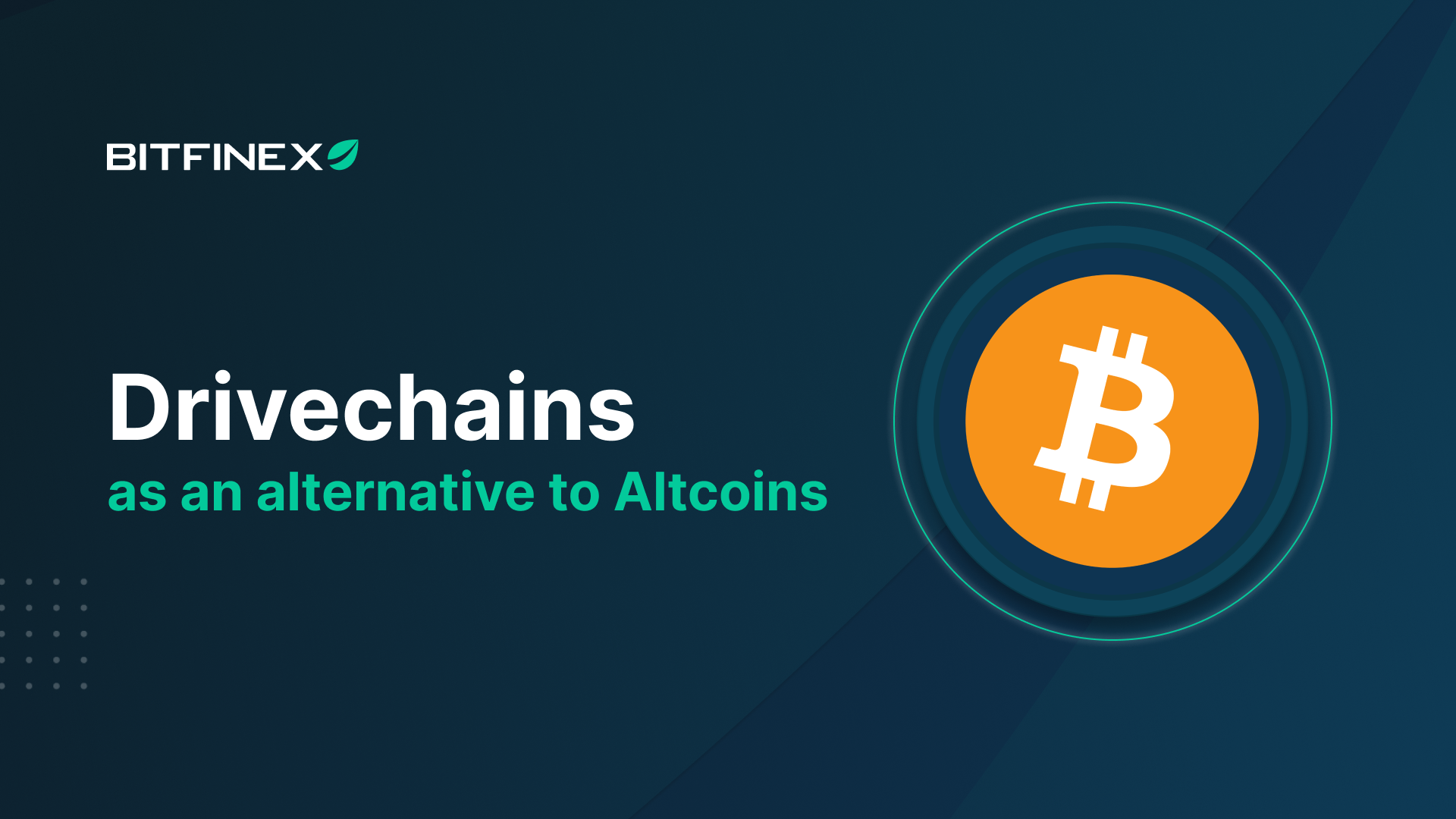
17 Feb Drivechains as an alternative to Altcoins
Drivechains are a Bitcoin layer two technology for side chains which allow for altcoins to exist on top of Bitcoin. This would offer several benefits like allowing permissionless experimentation, new features or use cases, eliminating competition between blockchains, and improved scalability. The downside is that they require a soft fork to implement.
The origins of Drivechains
If Paul Sztorc had got his way back in 2017 when he proposed Bitcoin Improvement Proposals (BIP) 300 and 301, the state of current crypto adoption would likely be very, very different. Paul’s two BIPs lay the groundwork for a decentralised Bitcoin sidechain implementation better known as “drivechains”, which leveraged Hashrate Escrow and Blind Merge Mining.
Sztorc first presented Drivechains in a blog post in 2015, and envisioned drivetrains as the way to both stop the fragmentation of Bitcoin caused by hard forks arising from consensus disagreements. As well as a way to absorb meaningful contributions from altcoin experimentation into Bitcoin and get rid of intertoken competition, which has fragmented adoption.
In the world possibly imagined by Sztorc, instead of our current cryptocurrency market, with Bitcoin and the 22,563 additional altcoins we have at the moment, we would have Bitcoin, and every other altcoin with a unique use case or coin with unique features existing on a sidechain as a drivechain, with its own blockchain being merge mined, by Bitcoin miners.
Drivechains in a nutshell
Drivechains would allow Bitcoin users to lock up BTC in these drivechains using a decentralised 2 way peg which utilises a cryptographic proof in order to mint coins that have characteristics or features of any altcoin.
Drivechains would operate as independent blockchains (on their own sidechains) and would be merge mined by Bitcoin miners, similar to the way the RSK (formerly known as Rootstock) sidechain is merge mined.
Drivechains would provide miners with additional fees, increase hashrate and Bitcoin security, and allow for new features and use cases which have seen massive adoption on altcoin chains, like Decentralised Finance (DeFi), Non Fungible Tokens (NFTs), security tokens, and stablecoins built on and backed by Bitcoin.
Drivechains would allow for experimentation on Bitcoin, without harm to the base layer one blockchain. It could possibly make altcoins obsolete, and allow Bitcoin to take the best or most successful features and use cases from any existing altcoin, without modifying Bitcoin’s code. Instead of launching a new altcoin on its own blockchain, it could be launched as a drivechain on Bitcoin.
Why haven’t Drivechains been added to Bitcoin?
Recently, the conversation surrounding drivechains on social media has picked up again as a new wave of Bitcoiners have shown renewed interest in revisiting Sztorc’s ideas. Drivechains do offer quite a few benefits, with some tradeoffs which also need to be considered. As it stands in the original design for drivechains, they’d be an opt-in soft fork, similar to the Segwit, or Taproot soft forks.
Despite the potential for drivechains, with the current controversy surrounding Ordinals and Inscriptions, which leveraged some of the new capabilities provided by the recent Taproot soft fork’s Taproot spend scripts, it’s unlikely that we will see Bitcoiners rush to adopt a new soft fork, to implement drivechains in Bitcoin anytime soon.
How do Drivechains work?
Drivechains use Simplified Payment Verification (SPV) proofs to allow users to send Bitcoin to and from a sidechain, using a 2 way peg. Bitcoin is then locked in a special address onchain, which acts as an onchain vault or box, which store the coins.
The sidechain then checks for these locking transactions, and once it detects one, creates an appropriate amount of native sidechain tokens. These sidechain tokens could be created with any of the desired trade-offs or characteristics of any of the existing altcoin use cases which would be considered invalid under Bitcoin’s layer one onchain consensus rules.
A great example of the kind of altcoin characteristics sidechain tokens could contain is the zSide sidechain, which is a drivechain that uses Z-Cash’s ZK-SNARKS zero knowledge proofs for confidential and private transactions on the sidechain.
This is a single example, but any characteristics of any altcoin token scheme could be implemented on its own chain. Sidechain tokens could have faster blocks, lower fees, be NFTs, Smart Contracts, DeFi, Stablecoins, etc.
To convert sidechain tokens back into on-chain Bitcoin, the sidechain must validate the special withdrawal transaction on the sidechain, as well as making sure it is a valid transaction on the Bitcoin layer one blockchain, which pays out the coins stored in the vault address described above to a new kind of address, in a withdrawal transaction.
This validation happens on the sidechain, not on the Bitcoin blockchain. Once the withdrawal transaction is created on the sidechain, the funds are frozen on the sidechain, and submitted to the miners of the Bitcoin blockchain.
This withdrawal transaction can take a period of 13,150 blocks or roughly six months, to give Bitcoin blockchain and sidechain participants a chance to verify that it is in fact a valid spend determined by miner votes. This address which receives the withdrawal payout is a special address which must be agreed upon by all miners that it is able to receive the payout, through a voting process called Hashrate Escrow. If a withdrawal doesn’t get enough votes, it is invalid and no funds are transferred.
What are the tradeoffs of Drivechains?
There are currently several rebuttals made by Bitcoiners for why adding drivechains on Bitcoin is undesirable. The criticisms surrounding drivechains are very nuanced technical arguments and both sides of the debate have valid points.
To learn more about the pros and cons, it’s worth reading Paul Sztorc’s drivechain.info FAQ, which gives detailed responses to criticisms. See below for some of the criticisms.We leave it up to the reader to DYOR, and decide for themselves if the tradeoffs are worth the risk.
Criticism 1: Miners can steal user funds
Drivechain detractors point out that under the current drivechain implementation, miners could theoretically steal user funds when they withdraw coins back into Bitcoin on the main chain. While this is somewhat true, efforts have been made in the drivechain implementation to mitigate this from occurring including the 13,150 block waiting period for withdrawal transactions. The likelihood of miner theft is very low. Learn more by reading about drivechain’s security model, here.
Criticism 2: Drivechain creates new costs for miners
Another argument used by drivechain opponents is that because merge mining will increase the data on-chain, it will make nodes more expensive, and mining will become less profitable, which is bad in such a competitive low margin market. This is true, merge mining drivechain sidechains does require miners to verify a couple extra hashes, but this argument does not take into account the additional fees miners will earn which will garner them more profit and cancel out any additional costs incurred.
An additional rebuttal to this criticism is that blind merge mining is optional, and opt in only, so miners are not forced to undertake any sort of additional costs unless they wish to. If they do wish to participate, it can be assured that they have calculated the risk versus reward and decided that the fees are worth the incurred costs.
Criticism 3: The new fees pervert miner incentives
Another criticism in regards to drivechains is that the fees generated by drivechain’s sidechains could misalign the incentives and game theory for miners. This means that if it is more profitable to mine sidechain transactions for fees, than onchain, that miners could potentially become bad actors who reorg transactions or censor transactions out of a greedy self interest.
This is another argument which is also somewhat true, but may not actually play out in the way detractors imagine. It leads to another larger issue and conversation surrounding Bitcoin’s fee model, the block subsidy, and miner profitability. Traditionally, miners do whatever they can to earn as much as possible, their self interest is a major factor in Bitcoin’s security model, and the fees from blind merge mining fall within this incentive structure.
This argument is currently similar to the opponents of Ordinal Inscriptions complaining that blocks are being filled with JPEGS, instead of economic transactions, although the Inscriptions are paying fees, which makes them economic transactions that have paid for the blockspace they are utilising.



